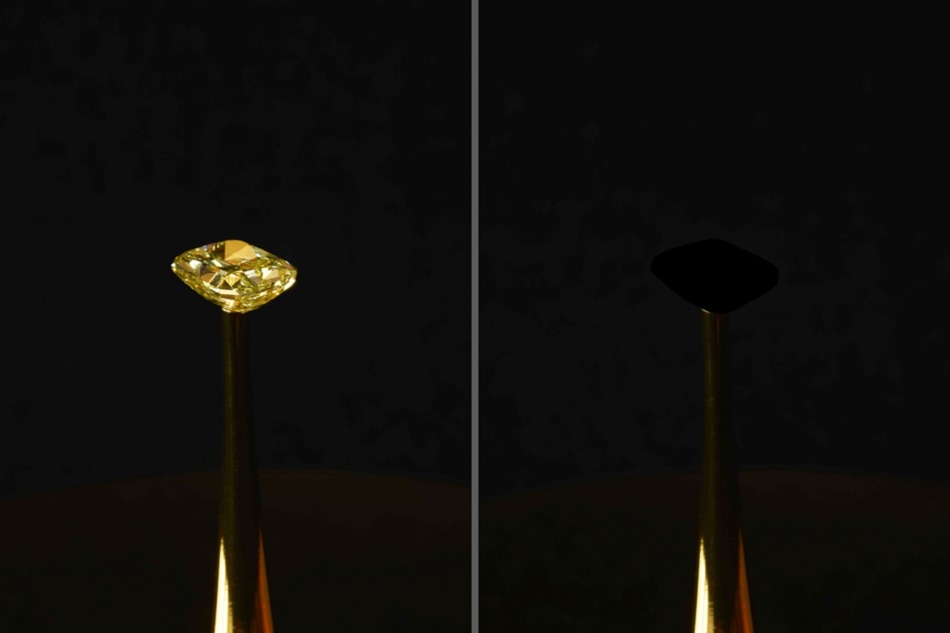
Image credit: R. Capanna, A. Berlato, and A. Pinato/ MIT
It seems that Vantablack has been eclipsed as the blackest ever black as engineers at MIT have brought into being a material that is capable of absorbing 99.995 percent of light – which beats the previous record of 99.965 percent held by the aforementioned Vantablack. On top of that is the fact that the light-absorbing properties of this newly discovered material which is yet to be given a voguish sounding name, are consistent from every possible angle.
The MIT team state in their release, “If the material contained bumps or ridges, or features of any kind, no matter what angle it was viewed from, these features would be invisible, obscured in a void of black.”
Often when one stares into the void long enough, the void stares back and this was certainly the case for the researchers who were not intent on developing a super-black material. Rather, the focus of their research was committed to finding new ways to cultivate carbon nanotubes on electrically conducting materials such as aluminum, in order to enhance their thermal and electrical properties. During their experiments the researchers noticed that the materials they were growing on treated aluminum foil were extraordinarily dark.
"I remember noticing how black it was before growing carbon nanotubes on it, and then after growth, it looked even darker," stated Kehang Cui, professor at Shanghai Jiao Tong University, co-author of the study, and former MIT post-doc. "So, I thought I should measure the optical reflectance of the sample," added Cui.
The accidental discovery came about due to the project facing a few minor hitches. When experimenting with the ways of growing carbon nanotubes, Cui noticed a coating of oxide that was present on the samples of aluminum. The consequence of this oxide coating was that rather than enhancing conductivity it acted as an insulator which led to Cui finding a solution using salt (Sodium chloride).
So, by then conducting a removal method using saltwater to soak and etch the coated foil and thereby remove the oxide layer, Cui and his team adopted a method to cultivate the carbon nanotubes. The process, dubbed chemical vapor deposition, involved placing the etched aluminum foil into an oven at lower temperatures than typically required. The success of their operation led to their findings confirming their expectations that the carbon nanotubes on the aluminum foil would significantly improve conductivity of both heat and electricity.
Once this process was completed it turned out to be the unique pitch-black appearance of the material that astonished the team. Even after determining light-absorbing qualities and clarifying the blackness of the material, the team are not entirely sure why the material is so dark. Early suggestions are that it is due to the specific combination of the blackened etched aluminum and carbon nanotubes – both of which complement one another to create this unexpected property. However, further research will be needed to determine exactly why this material is this way.
CNT forests of different varieties are known to be extremely black, but there is a lack of mechanistic understanding as to why this material is the blackest. That needs further study.
Brian Wardle, Professor of Aeronautics and Astronautics, MIT
Meanwhile, Wardle has collaborated with MIT artist-in-residence Diemut Strebe to display the material at the New York Stock Exchange as part of an exhibit titled, The Redemption of Vanity. “Our group does not usually focus on optical properties of materials, but this work was going on at the same time as our art-science collaborations with Diemut, so art influenced science in this case,” says Wardle. Strebe worked with the researchers in coating a 16.76-carat yellow diamond, valued at 2 million USD, in the new super-black material.
The result is the consumption of the diamond in a void of light as a challenge to the art market and “aesthetic asceticism”. Furthermore, "Because of the extremely high light absorptive qualities of the carbon nanotubes, any object, in this case a large diamond coated with carbon nanotubes, becomes a kind of black hole absent of shadows … In this sense it manifests an inquiry into the significance of the value of objects of art and the art market,” says Strebe.
Super-black materials have great potential beyond art-exhibits and have attracted the gaze of the aerospace community. John Mather, astrophysicist and Nobel laureate, hopes to put the research of Wardle and Cui to good use in the development of a shade designed to protect a space telescope from intruding light. “Optical instruments like cameras and telescopes have to get rid of unwanted glare, so you can see what you want to see,” Mather says. “Would you like to see an Earth orbiting another star? We need something very black. … And this black has to be tough to withstand a rocket launch. Old versions were fragile forests of fur, but these are more like pot scrubbers — built to take abuse."
Disclaimer: The views expressed here are those of the author expressed in their private capacity and do not necessarily represent the views of AZoM.com Limited T/A AZoNetwork the owner and operator of this website. This disclaimer forms part of the Terms and conditions of use of this website.